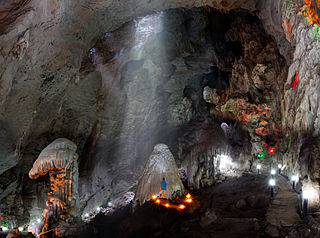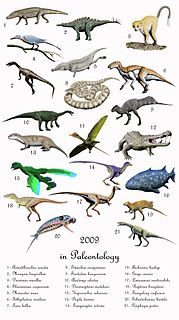
Nong Bua Lamphu is one of Thailand's seventy-seven provinces (changwat) lies in upper northeastern Thailand also called Isan. Neighbouring provinces are Udon Thani, Khon Kaen, and Loei.

Siamotyrannus is a genus of carnivorous metriacanthosaurid theropod dinosaur from the early Cretaceous of Thailand.

Siamosaurus is a genus of spinosaurid dinosaur that lived in what is now known as China and Thailand during the Early Cretaceous period and is the first reported spinosaurid from Asia. It is confidently known only from tooth fossils; the first were found in the Sao Khua Formation, with more teeth later recovered from the younger Khok Kruat Formation. The type species Siamosaurus suteethorni, whose name honours Thai palaeontologist Varavudh Suteethorn, was formally described in 1986. In 2009, four teeth from China previously attributed to a pliosaur—under the species "Sinopliosaurus" fusuiensis—were identified as those of a spinosaurid, possibly Siamosaurus. It is yet to be determined if two partial spinosaurid skeletons from Thailand and an isolated tooth from Japan also belong to Siamosaurus.

Kinnareemimus is a genus of ornithomimosaurian theropod dinosaur from Thailand. It is known only from incomplete remains discovered no later than the early 1990s that includes vertebrae, partial pubic bones, metatarsals, and an incomplete fibula. The third metatarsal exhibits a distinctive lateral "pinching", known as the "arctometarsalian" condition, variations of which are found in ornithomimosaurs, tyrannosauroids, troodontids, and caenagnathids. Its remains were collected from the Early Cretaceous Sao Khua Formation, dating to the Barremian stage, at Phu Wiang, Khon Kaen Province. Its early occurrence makes it among the earliest ornithomimosaur known, depending on the age of the formation. Buffetaut et al. suggest the fossils of Kinnareemimus may indicate an Asian origin for advanced ornithomimosaurs.

Phuwiangosaurus is a genus of titanosaur dinosaur from the Early Cretaceous (Valanginian-Hauterivian) Sao Khua Formation of Thailand. The type species, P. sirindhornae, was described by Martin, Buffetaut, and Suteethorn in a 1993 press release and was formally named in 1994. The species was named to honor Princess Maha Chakri Sirindhorn of Thailand, who was interested in the geology and palaeontology of Thailand, while the genus was named after the Phu Wiang area, where the fossil was discovered.

Hybodontiformes, also called hybodonts, are an extinct subset of Elasmobranchii which existed from the late Devonian to the Late Cretaceous. They form the group of sharks closest to neoselachians, the clade of modern sharks and rays. Hybodonts were named and are distinguished based on their conical tooth shape. They comprised the main group of Jurassic sharks in Europe and North America. They survived into the Late Cretaceous before going extinct, possibly due to competition from other sharks. Lonchidion was one of the last hybodonts — its distinctive serrated fine spines occur in freshwater deposits from Wyoming alongside the fossils of the last non-avian dinosaurs, including Tyrannosaurus rex and Triceratops. Hybodontiformes are identified in the fossil record predominantly based on distinct teeth and fin spines. They were known to live in both fresh and salt water environments.

Paleontology or palaeontology is the study of prehistoric life forms on Earth through the examination of plant and animal fossils. This includes the study of body fossils, tracks (ichnites), burrows, cast-off parts, fossilised feces (coprolites), palynomorphs and chemical residues. Because humans have encountered fossils for millennia, paleontology has a long history both before and after becoming formalized as a science. This article records significant discoveries and events related to paleontology that occurred or were published in the year 2009.

Mamenchisauridae is a family of sauropod dinosaurs known from the Jurassic and Early Cretaceous of Asia and Africa.
Siamamia is an extinct genus of ray-finned fish from Northeasthern Thailand. They belong to family Sinamiidae and are halecomorph fishes endemic to Early Cretaceous freshwater environments in eastern Asia.

Phu Wiang Dinosaur Museum is a geological museum mainly exhibiting fossils. It is under the administration of the Department of Mineral Resources, Ministry of Natural Resources and Environment, of the Royal Thai Government, and situated in the Khok Sanambin public area in Tambon Nai Muang, Wiang Kao district, Khon Kaen province in the northeastern region of Thailand. The museum was constructed with a budget from the Tourism Authority of Thailand under the supervision of the Department of Mineral Resources and comprises an area of 40 acres (160,000 m2). It has been open to the public since 2009.
The Early Cretaceous Phu Kradung Formation is the lowest member of the Mesozoic Khorat Group which outcrops on the Khorat Plateau in Isan, Thailand. This geological formation consists of micaceous, brown to reddish-brown siltstone beds with minor brown and grey shale and sandstone beds. Occasional lime-noduled conglomerate occurs.
Khoratosuchus is an extinct genus of neosuchian crocodylomorph which existed in northeast Thailand during the early Cretaceous period. Its type species is Khoratosuchus jintasakuli. Khoratosuchus is the youngest and most advanced Mesozoic crocodyliform yet known from Thailand. It possesses several distinctive features that help determine its phylogenetic position among crocodylomorphs, including secondary choanae relatively posterior and almost encircled by the pterygoid bones on the palate and a smooth dorsal surface of the skull.
Sunosuchus is an extinct genus of goniopholidid mesoeucrocodylian. Fossils are known from China, Kyrgyzstan, and Thailand and are Jurassic in age, although some may be Early Cretaceous. Four species are currently assigned to the genus: the type species S. miaoi and the species S. junggarensis, S. shartegensis, and S. shunanensis. All species are from China. Goniopholis phuwiangensis, also from Thailand, was reassigned to Sunosuchus by Andrade et al. (2011). The material from Kyrgyzstan has not been assigned to any species.
The Khok Kruat Formation is a rock formation found in northeastern Thailand. It is the uppermost formation of the Khorat Group. It is dated to the Aptian stage of the Early Cretaceous period, and is notable for its fossils of dinosaurs. It is equivalent to the Gres superieurs Formation of Laos. The group is a fluvial formation consisting primarily of red siltstones and sandstones.

Chalawan is an extinct genus of pholidosaurid mesoeucrocodylian known from the Late Jurassic or Early Cretaceous Phu Kradung Formation of Nong Bua Lamphu Province, northeastern Thailand. It contains a single species, Chalawan thailandicus, with Chalawan shartegensis as a possible second species.

Coelognathosuchia is an extinct clade of neosuchian crocodyliforms that includes all taxa more closely related to the family Pholidosauridae than to Bernissartia fagesii or Eusuchia. Martin et al. (2014) named the clade after finding goniopholidids and pholidosaurids to group together in their phylogenetic analysis of crocodyliform evolutionary relationships. In their analysis, Pholidosauridae was monophyletic and Goniopholididae was paraphyletic, being an assemblage of successively more basal taxa within Coelognathosuchia. Coelognathosuchia itself was positioned near the base of the larger clade Neosuchia as the sister group to a clade containing the Early Cretaceous neosuchian Bernissartia and Eusuchia, the group that includes all modern crocodilians and their closest extinct relatives.

Xinjiangchelyidae is an extinct family of turtles known from the Lower Jurassic to the Middle Cretaceous of Asia and western Europe. They have generally been interpreted as either being basal cryptodires or placed outside of crown Testudines.
Varavudh Suteethorn, or Warawut Suteethorn is a Thai geologist and palaeontologist. He is the current director of the Palaeontological Research and Education Centre, Mahasarakham University. He is best known for his work on vertebrate palaeontology in northeastern Thailand, having contributed to the discovery of many fossil taxa and dig sites in the Khorat Plateau, as a part of a long-standing collaboration between Thai and French scientists.
Phuwiangvenator is a genus of 6 meter long megaraptoran theropod that lived during the Early Cretaceous period in what is now Thailand. It contains a single species, P. yaemniyomi, recovered from the Sao Khua Formation. The holotype was first found in 1993, before being named in 2019. The holotype specimen consists of a partial skeleton consisting of a dorsal vertebra, three fused sacral vertebrae, right metacarpal II, right manual phalanges and unguals, right and left tibiae, left astragalocalcaneum, left metatarsal I, right metatarsals II–IV, right pedal phalanges and unguals, with a referred specimen including an atlantal intercentrum and right astragalocalcaneum which were found together. In the phylogenetic analyses it was found to be the basalmost megaraptoran. Additional materials belonging to the holotype were described in 2021.

Yakemys is an extinct genus of macrobaenid turtles from the Late Jurassic-Early Cretaceous (Tithonian-Valanginian?) lower Phu Kradung Formation of Thailand. It is monotypic, containing a single species, Yakemys multiporcata.












